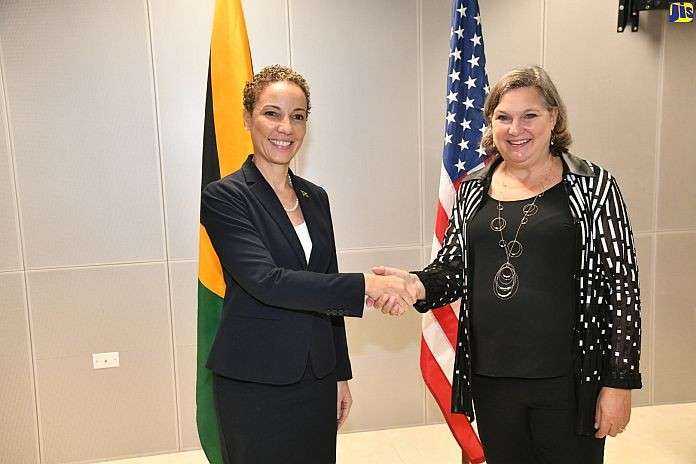BY PAUL JUNOR
The Caribbean News Global made the announcement that the United States will make an additional investment of $34 million to Jamaica in a press release on Saturday, November 26th.
The funds will be earmarked for: violence reduction, combatting trafficking, cyber security, energy security, and initiatives to boost the economy. Ambassador Victoria Nuland, United States Under Secretary of State for Political Affairs revealed details to Senator Kamina Johnson Smith, Minister of Foreign Affairs and Foreign Trade during the US-Jamaica strategic dialogue held in downtown Kingston.
There will be an extra $3.5 million in support that will go towards fighting violent crime and homicide as the state department’s bureau of international narcotics and law enforcement affairs increases its budget by 200%. Ambassador Nuland stated,“ Our trafficking in persons office has committed US $7 million to helping Jamaica combat child trafficking through the Child Protection Compact Partnership.”
Furthermore, additional benefits of the Jamaica-US partnership will facilitate support for: climate adaptation, strengthening of energy security and the development of clean energy projects. Through the help of the US law enforcement, in cooperation with the Jamaican government there has been the extradition of 23 wanted criminals to the US.
It has been two years now since the US-Jamaica partnership has been in operation. They aim to advance shared interests in: security, prosperity and democracy in the Western atmosphere. The strengthening of data collection mechanisms and sharing is intended to improve Jamaican law enforcement‘s ability to collect and retain fingerprints for use in criminal investigations.
On Sunday, November 27th, 2022 an article by Charnele Henry for Caribbean News Global revealed that Jamaica will be able to access more global funding as a result of the climate finance strategy. Dr.Christian DaSilva, Head of Cooperation, and Canadian High Commission in Jamaica made the announcement.
The Global Affairs Canada (a department of the Government of Canada) will provide funds to the Government of Jamaica (GOJ) that will enable it to conceptualize a plan that enables it to obtain additional global funding. Technical assistance from two consultants will help to develop a climate finance strategy through the Planning Institute of Jamaica PIOJ) that will be under the Canada-CARICOM Expert Deployment Mechanism (CCEDM).
Dr.DaSilva is hopeful about this unique “assignment pipeline,” which he believes has the potential to smooth the way for more development assistance to flow for the Government of Canada. There has been international attention focused on COP27 which concluded recently in Egypt. This development strategy will go a long way to help to implement Jamaica’s climate objectives, and meet the Nationally Determined Contributions (NDCs) and other commitments made under the Paris Agreement.
At a recent “Think Tank ” by the Jamaica Information Service (JIS) focus was on CCEDM. Dr.DaSilva observes that for the establishment of creative global financing, Jamaica must be uniquely positioned to access this additional funding. He states, “It’s going to take some time, but once that strategy is in place, I think the value of the consultancy could be multiplied by a hundred-fold in terms of the kind of finance that would flow to the government to help implement climate action.”
Barbara Scott (Deputy Director General, External Cooperation Management and Project Development, PIOJ) acknowledged that gaps would be observed with respect to current climate action. She states, “What is needed is for a scan to be done for us to look at all the projects that are being implemented, the areas that are being addressed, and where the gaps are, and then putting in place a strategic framework which shows, based on our commitments, these are the priority areas which needed to be addressed in the short and medium term.”

